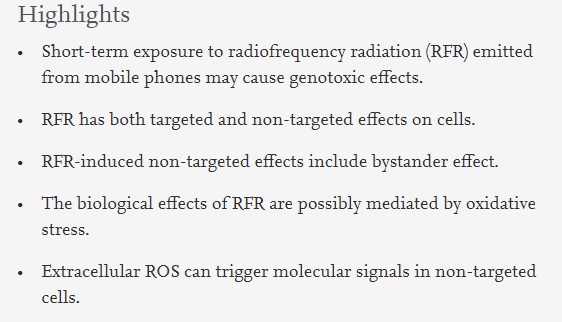https://doi.org/10.1016/j.envres.2019.03.063

Abstract
Introduction
The rapid rise in global concerns about the adverse health effects of exposure to radiofrequency radiation (RFR) generated by common devices such as mobile phones has prompted scientists to further investigate the biological effects of these environmental exposures. Non-targeted effects (NTEs) are responses which do not need a direct exposure to be expressed and are particularly significant at low energy radiations. Although NTEs of ionizing radiation are well documented, there are scarcely any studies on non-targeted responses such as bystander effect (BE) after exposure to non-ionizing radiation. The main goal of this research is to study possible RFR-induced BE.
Material and methods
Chinese hamster ovary cells were exposed to 900 MHz GSM RFR at an average specific absorption rate (SAR) of 2 W/kg for 4, 12 and 24 hours (h). To generate a uniformly distributed electromagnetic field and avoid extraneous RF exposures a cavity was desined and used. Cell membrane permeability, cell redox activity, metabolic and mitotic cell death and DNA damages were analyzed. Then the most effective exposure durations and statistically significant altered parameters were chosen to assess the induction of BE through medium transfer procedure. Furthermore, intra and extra cellular reactive oxygen species (ROS) levels were measured to assess the molecular mechanism of BE induced by non-ionizing radiation.
Results
No statistically significant alteration was found in cell membrane permeability, cell redox activity, metabolic cell activity and micronuclei (MN) frequency in the cells directly exposed to RFR for 4, 12, or 24 h. However, RFR exposure for 24 h caused a statistically significant decrease in clonogenic ability as well as a statistically significant increase in olive moment in both directly exposed and bystander cells which received media from RFR-exposed cells (conditioned culture medium; CCM). Exposure to RFR also statistically significant elevated both intra and extra cellular levels of ROS.
Conclusion
Our observation clearly indicated the induction of BE in cells treated with CCM. To our knowledge, this is the first report that a non-ionizing radiation (900 MHz GSM RFR) can induce bystander effect. As reported for ionizing radiation, our results proposed that ROS can be a potential molecule in indirect effect of RFR. On the other hand, we found the importance of ROS in direct effect of RFR but in different ways.
© 2019 Elsevier Inc. All rights reserved.
